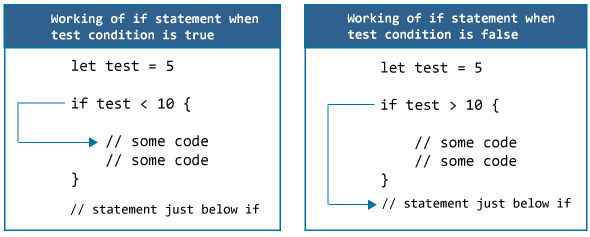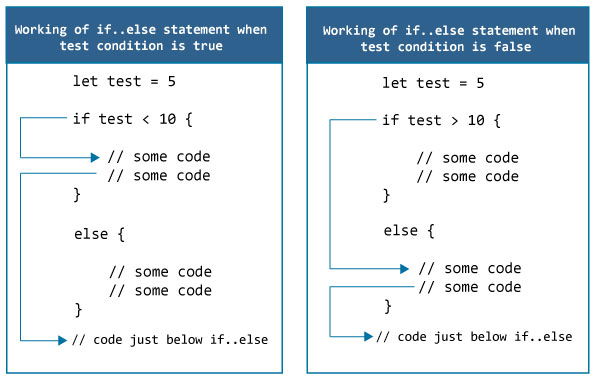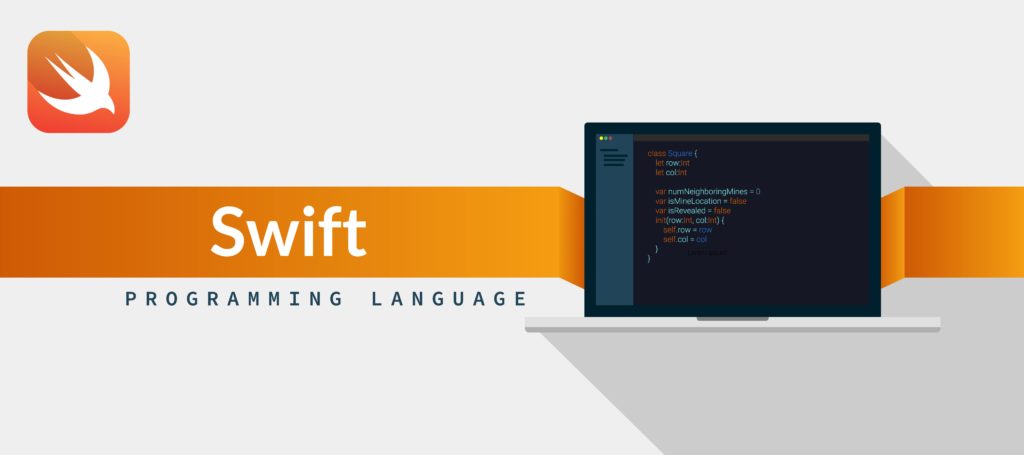(Swift for Beginners)
Swift if, if…else Statement
In this article, you will learn to use two conditional statements: if and if…else to control the flow of your program’s execution.
In programming, you may want to perform different actions based upon the specified condition is true or false (which is known only during the run time). For such cases, control flow statements are used.
Swift if (if-then) Statement
The syntax of if statement in Swift is:
if expression {
// statements
}
- Here
expressionis a boolean expression (returns eithertrueorfalse). - If the
expressionis evaluated totrue, statements inside the code block ofifis executed. - If the
expressionis evaluated tofalse, statements inside the code block ofifare skipped from execution.
How if statement works?

Example 1: Swift if Statement
let number = 10
if number > 0 {
print("Number is positive.")
}
print("This statement is always executed.")
When you run the program, the output will be:
Number is positive. This statement is always executed.
In the above program, we have initialized constant number with value 10 and the test expression number > 0 evaluates to true. Hence, the statement print("Number is positive.") inside the body of if statement is executed which outputs Number is positive. in the console..
Now, change the value of number to a negative integer. Let’s say -5. The output in this case will be:
This statement is always executed.
When number is initialized with value -5, the test expression number > 0 is evaluated to false. Hence, Swift compiler skips the execution of body of if statement.
Swift if..else (if-else) Statement
The if statement executes a certain section of code if the test expression is evaluated to true. The if statement can have optional else statement. Code inside the body of else statement are executed if the test expression is false.
The syntax of if-else statement is:
if expression {
// statements
} else {
// statements
}
How if..else statement works?

Example 2: Swift if else Statement
let number = 10
if number > 0 {
print("Number is positive.")
} else {
print("Number is not positive.")
}
print("This statement is always executed.")
When you run the program, the output will be:
Number is positive. This statement is always executed
In the above program, constant number is initialized with value 10 and the test expression number > 0 evaluates to true. Hence,the statement print("Number is positive.") inside the body of if statement is executed.
This outputs Number is positive. in the console and the statements inside the body of else are skipped from execution.
Now, change the value of number to a negative number. Let’s say -5. The output in this case will be:
Number is not positive. This statement is always executed.
When number is -5, the test expression number > 0 is evaluated to false. In this case, statements inside the body of else are executed, and statements inside the body of if are skipped from execution.
You can also replace if..else statement with ternary operator in Swift, which is kind of a shorthand notation of if…else statement.
Swift if..else..if (if-else-if) Statement
In Swift, it’s also possible to execute one block of code among many. For that, you can use if..else..if ladder as:
The syntax of if-else-if statement is:
if expression1 {
// statements
}
else if expression2 {
// statements
}
else if expression3 {
// statements
}
.
.
else {
// statements
}
The if statements are executed from the top towards the bottom. As soon as the test expression is true, codes inside the body of that if statement is executed. Then, the control of program jumps outside if-else-if ladder.
If all test expressions are false, code inside the body of else is executed
Example 3: Swift if..else..if Statement
The following program checks whether number is positive, negative or 0.
let number = 0;
if number > 0 {
print("Number is positive.")
}
else if (number < 0) {
print("Number is negative.")
}
else {
print("Number is 0.")
}
When you run the program, the output will be:
Number is 0.
In the above program, constant number is initialized with value 0. Since if statements are executed from top to bottom, it checks the expression number > 0 which evaluates to false.
It then checks the next expression number < 0 which also evaluates to false.
Hence, the statement print("Number is 0.") inside the body of else is executed which outputs Number is 0. in the console.
Swift nested if..else Statement
It’s possible to have if..else statements inside an if..else statement in Swift. It’s called nested if…else statement.
You can also replace nested if..else statement with switch in Swift which is sometimes a simpler approach when dealing with several possible options.
The syntax of nested if-else statement is:
if expression1 {
if expression2 {
// statements
} else {
// statements
}
}
else {
if expression3 {
// statements
} else {
// statements
}
}
Example 4: Nested if…else Statement
Here’s a program to find largest of 3 numbers using nested if else statements.
let n1 = -1.0, n2 = 4.5, n3 = -5.3
if n1 >= n2 {
if n1 >= n3 {
print("Largest number is ", n1)
}
else {
print("Largest number is ", n3)
}
}
else {
if n2 >= n3 {
print("Largest number is ", n2)
}
else {
print("Largest number is ", n3)
}
}
When you run the above program, the output will be:
Largest number is 4.5
Swift programming for Beginners – Swift if, if…else Statement
Disclaimer: The information and code presented within this recipe/tutorial is only for educational and coaching purposes for beginners and developers. Anyone can practice and apply the recipe/tutorial presented here, but the reader is taking full responsibility for his/her actions. The author (content curator) of this recipe (code / program) has made every effort to ensure the accuracy of the information was correct at time of publication. The author (content curator) does not assume and hereby disclaims any liability to any party for any loss, damage, or disruption caused by errors or omissions, whether such errors or omissions result from accident, negligence, or any other cause. The information presented here could also be found in public knowledge domains.
Learn by Coding: v-Tutorials on Applied Machine Learning and Data Science for Beginners
Latest end-to-end Learn by Coding Projects (Jupyter Notebooks) in Python and R:
All Notebooks in One Bundle: Data Science Recipes and Examples in Python & R.
End-to-End Python Machine Learning Recipes & Examples.
End-to-End R Machine Learning Recipes & Examples.
Applied Statistics with R for Beginners and Business Professionals
Data Science and Machine Learning Projects in Python: Tabular Data Analytics
Data Science and Machine Learning Projects in R: Tabular Data Analytics
Python Machine Learning & Data Science Recipes: Learn by Coding
R Machine Learning & Data Science Recipes: Learn by Coding
Comparing Different Machine Learning Algorithms in Python for Classification (FREE)
There are 2000+ End-to-End Python & R Notebooks are available to build Professional Portfolio as a Data Scientist and/or Machine Learning Specialist. All Notebooks are only $29.95. We would like to request you to have a look at the website for FREE the end-to-end notebooks, and then decide whether you would like to purchase or not.
